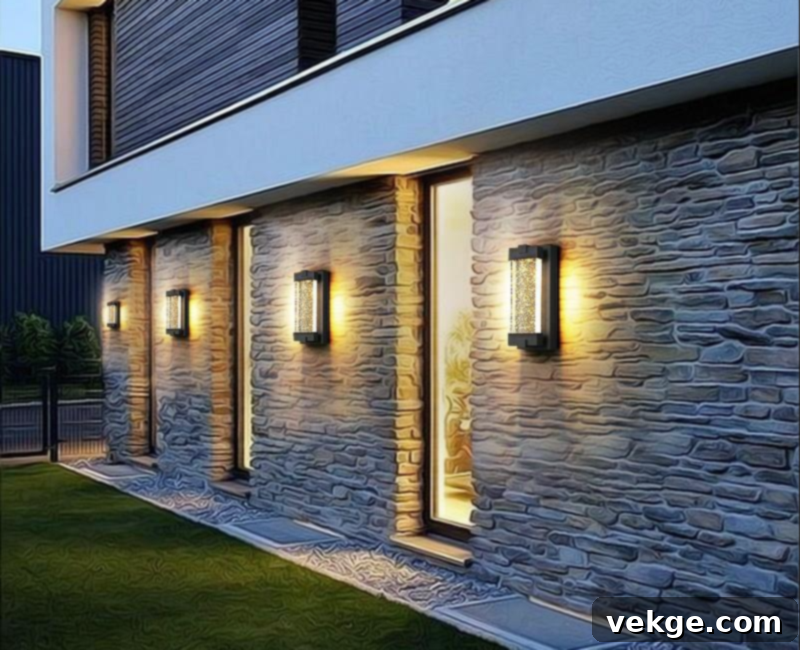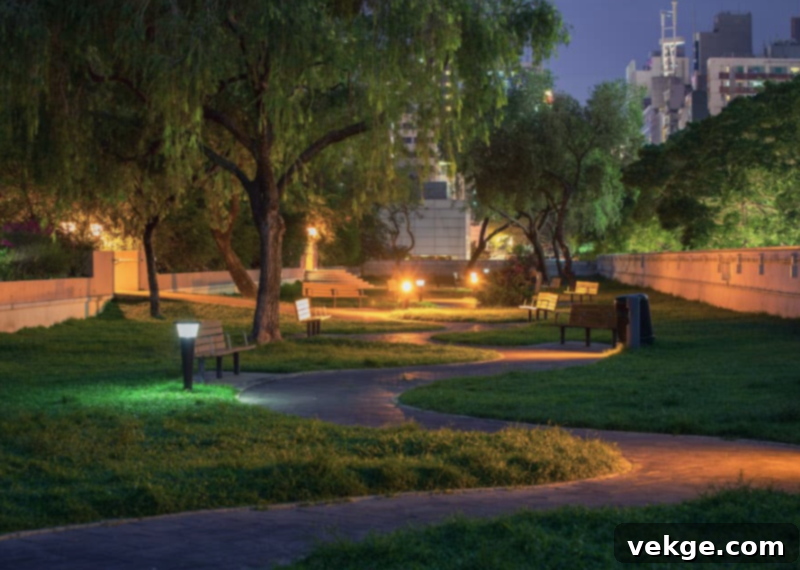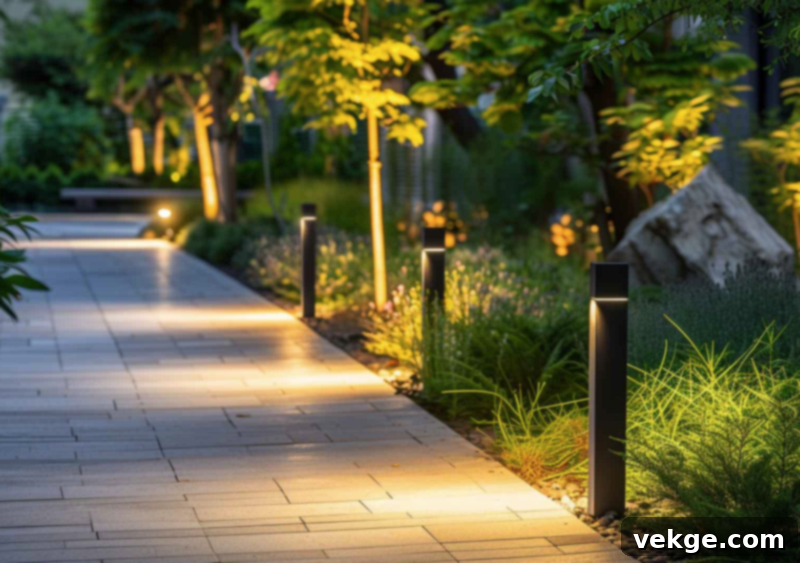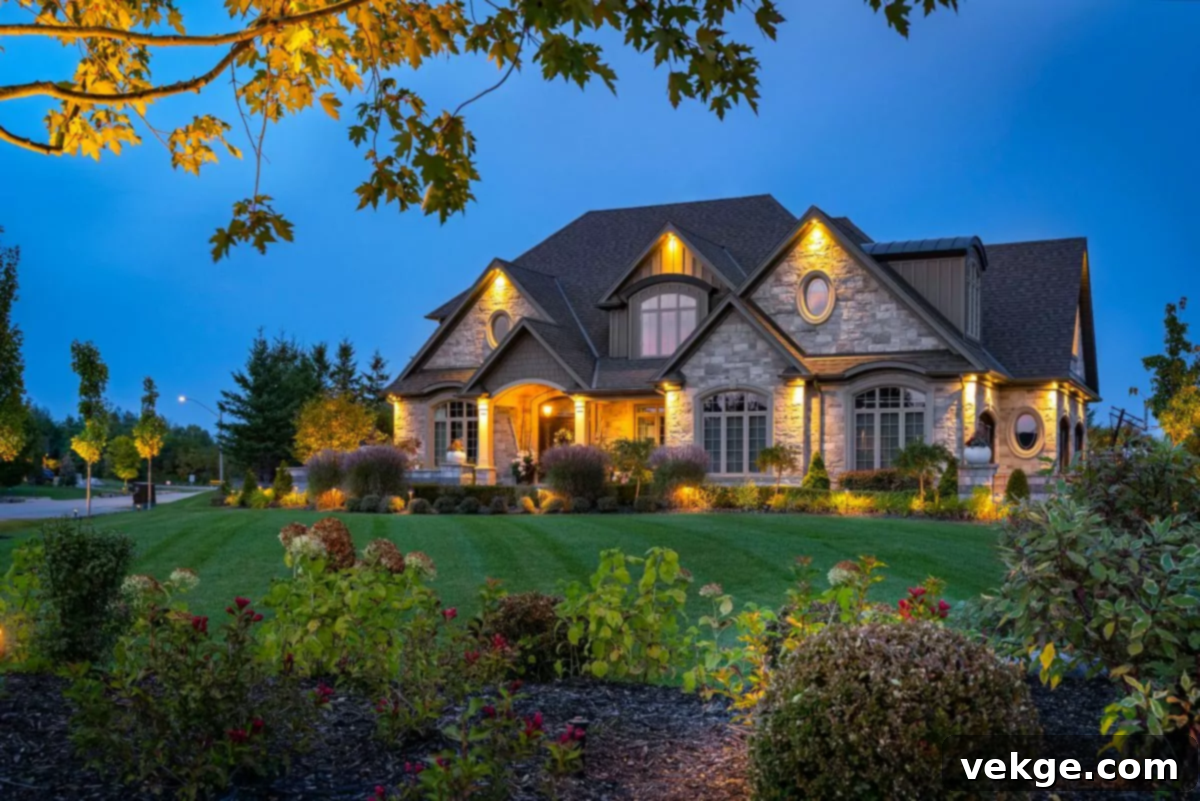Mastering Outdoor Lighting: A Comprehensive Guide to Illuminating Your Home and Garden
Imagine stepping out on a tranquil summer evening, not stumbling in the dark, but confidently strolling onto a beautifully lit patio, your garden’s best features gently highlighted. This transformation from an awkward shuffle to a relaxed ambiance is easily achievable with a thoughtful outdoor lighting plan. Far more than just banishing shadows, well-designed outdoor lighting enhances safety, boosts security, extends your living space, and dramatically elevates your home’s curb appeal after dusk.
The secret to successful outdoor illumination lies in two core principles: judicious placement and appropriate fixture selection. You want to place light precisely where it’s needed, not just indiscriminately. And for every task—whether it’s guiding pathways, accentuating foliage, or deterring intruders—there’s a specific type of fixture engineered to do the job best. By understanding the diverse range of options available and their ideal applications, you can create a harmonious and functional lighting scheme that feels intentional and inviting, rather than haphazard.
What Are the Different Types of Outdoor Lights?

Outdoor lighting fixtures are categorized into several distinct groups, each designed for a particular function and aesthetic. Matching the right style to the right location ensures you achieve a brilliant, durable, and cohesive outdoor lighting system. Let’s explore the most common types of outdoor lights and their ideal applications.
Wall Lights
Wall lights are perhaps the most ubiquitous outdoor fixtures, serving as both functional illumination and decorative elements for building façades, porches, garage doors, and entryways. These versatile lights provide essential guidance and a welcoming glow. Modern LED wall lights offer a spectrum of color temperatures, from the warm, inviting amber of 2700K—perfect for a cozy reading nook or a welcoming front door—to the crisper, more neutral white of 4000K, ideal for illuminating side entries or practical work areas. Their output varies widely, from subtle 1W accent chips that add a gentle wash to powerful 100W equivalents capable of brightly illuminating expansive brick walls.
When selecting wall lights, consider their exposure to the elements. An IP44 rating is sufficient for covered verandas and sheltered porches, offering protection against splashing water. However, for units fully exposed to rain and harsher conditions, an IP65 rating provides superior protection against water jets and dust ingress. Aesthetically, wall lights come in an array of finishes, including classic black, contemporary brushed steel, sleek powder-coated white, and even vibrant hues like bright red, allowing them to either blend seamlessly with your home’s exterior or stand out as a distinctive design feature.
For optimal visual comfort and natural appearance in family photos, always check for a Color Rendering Index (CRI) of over 80. This ensures that colors, especially skin tones, appear true-to-life under the light. Integrated LEDs boast impressive lifespans, typically around 50,000 hours, though fixtures accepting screw-in lamps offer flexibility for future upgrades or bulb replacements. Many contemporary models include built-in photocells, automatically activating lights at dusk and deactivating them at dawn, enhancing convenience and energy efficiency. Pairing these with a motion sensor on service doors or key entry points adds an extra layer of security, illuminating only when needed, thus preventing unnecessary power consumption. For longer wiring runs, using 12 AWG cable is recommended to maintain consistent voltage and keep voltage drop under 3%, ensuring uniform brightness across all fixtures.
Mounting wall lights is relatively straightforward. Position the center of the fixture approximately 170 cm (around 67 inches) above the finished ground. For a single front door, flanking the frame with a pair of wall lights creates an inviting, even wash of light and eliminates harsh shadows. For a two-car garage, position two lamps about 25 cm (10 inches) beyond each edge of the garage doors, allowing their beams to overlap in the center. If the façade is particularly wide, a third lamp centered above the doors can provide additional balance and illumination. To minimize light pollution and glare, subtly tilt adjustable heads slightly downward. Regular cleaning of lenses, at least once a season, is vital to maintain full light output and ensure your wall lights always perform at their best.
Garden Spike Lights

Garden spike lights, often referred to as spot stakes or uplights, are indispensable tools for landscape lighting, allowing for precise beam targeting along garden beds, under shrubs, or highlighting architectural features. Their versatility makes them perfect for creating dramatic effects and subtle accents. LED chips in these fixtures range from a modest 3W, ideal for a gentle glow on delicate flowers or small pathway illumination, up to a powerful 50W, capable of delivering dramatic uplighting for a two-meter birch tree or a prominent garden sculpture. When choosing color temperature, 3000K offers a warm, golden hue that beautifully complements green foliage and natural stone, while 4000K provides a more neutral light, making textures pop without any yellow cast. The ability to pivot the heads on a knuckle allows for quick and easy fine-tuning of the light’s direction, ensuring your design vision is perfectly realized.
Given their proximity to the ground and exposure to moisture, selecting garden spike lights with at least an IP65 housing is crucial. This rating guarantees robust protection against rain and sprinkler spray, ensuring longevity. These durable fixtures typically feature aluminum bodies, available in various finishes like matte black, dark green, sandstone, or copper, which develops a beautiful, warm brown patina over time. Beam angles are a critical consideration: a narrow 15° beam is excellent for accentuating specific statues or slender trees, while wider angles up to 60° are better suited for washing larger shrubs or a section of a fence. For pathway edging, small 3W spikes spaced one meter apart create a gentle, guiding light. To evenly wash the trunk of a two-meter ornamental tree, a single 9W unit placed one meter from its base works effectively. For maximum stability in loose earth, opt for spikes that feature a screw-in collar, firmly clamping the stake in place.
Wiring for garden spike lights is generally straightforward. Low-voltage systems typically use 2-core 2.5 mm² cable, buried approximately 150 mm (6 inches) deep for protection. All joints should be sealed with gel-filled caps to prevent moisture ingress and ensure electrical safety. To prevent noticeable dimming at the far end of the circuit, keep cable runs under 30 meters (about 100 feet) or step up to 12 AWG cable for longer distances. Integrating a dusk-to-dawn photocell or connecting the circuit to a smart home hub allows your garden beds to automatically glow after sunset, adding convenience and energy savings. For an instant mood shift, consider swapping clear lenses for amber in autumn to enhance fall colors, or ice blue at Christmas to create a festive winter wonderland effect.
Floodlights
Floodlights are designed to cast a broad, powerful beam of light, ideal for illuminating expansive areas such as driveways, sports courts, large patios, or the facades of buildings, ensuring no dark pockets remain. Modern LED floodlights offer significant power flexibility, ranging from 9W for a compact courtyard to a robust 150W, capable of brightly lighting a half-court basketball area, allowing you to perfectly match the light output to the size and purpose of your space. Color temperature choices are also varied: 3000K provides a warm, inviting light suitable for social gatherings, while higher temperatures up to 6500K deliver a crisp, bright light, excellent for security purposes around workshop doors or commercial properties. When evaluating efficiency, aim for at least 80 lumens per watt (lm/W); many advanced units achieve 120 lm/W or more, indicating superior energy performance.
Proper mounting is essential to maximize effectiveness and minimize glare. Fixtures should generally be mounted around 250 cm (about 8 feet) high to keep the light source out of direct eye line while ensuring the beam sweeps across the ground effectively. A typical two-car driveway might only require one 30W lamp mounted at 270 cm (9 feet) on the garage gable. For larger zones or properties, consider a pole-mounted floodlight at 4 meters (13 feet), tilted about 30 degrees, so the beam lands approximately 5 meters (16 feet) in front, providing extensive coverage. Given their exposed nature, an IP65 or IP66 rating is critical for floodlight housings, ensuring complete protection against dust and powerful water jets. Die-cast aluminum bodies paired with a tempered-glass lens guarantee long-term durability. If your property is near the coast, investing in a marine-grade finish will protect against corrosive saltwater environments.
Smart controls significantly enhance both convenience and efficiency. Many new floodlights feature a passive infrared (PIR) sensor that activates the light only when movement is detected within its zone. To prevent false triggers from small animals, set the timeout to about 60 seconds and the sensitivity to a medium level. For continuous illumination during activities like a backyard game, a smart switch can override the sensor, providing steady light. On long outdoor electrical runs, installing a surge protector is a wise precaution to shield the sensitive LED driver circuits from lightning strikes and power surges. Additionally, be aware that some municipalities enforce brightness limits for floodlights, often capping them at 1,000 lumens per square meter, so choosing a model with adjustable output can help ensure compliance with local regulations.
Post Lights and Bollards

Post lights and bollards provide elegant, eye-level illumination, perfect for defining pathways, outlining patio borders, or guiding visitors along driveways with a soft, inviting glow. The LED modules within these fixtures are remarkably energy-efficient, with most models drawing only 1.3W to 16.4W, yet still delivering ample light to ensure safe passage. Their warm color temperatures, typically ranging from 2700K to 3000K, beautifully mimic the welcoming ambiance of candlelight without the open flame. Heights vary considerably to suit different applications: bollards typically stand 60–90 cm (24–35 inches) tall, ideal for pathway definition, while taller driveway posts can reach approximately 1.6 meters (5.2 feet), providing more expansive area lighting.
Careful spacing is crucial for achieving the desired aesthetic and functionality. To avoid a “runway effect” and create a continuous wash of light, maintain center-to-center gaps at two to three times the fixture’s height. For instance, a 70 cm bollard spaced every 1.5 meters (5 feet) feels balanced, preventing harsh pools of light and ensuring even illumination. For secure installation, anchor the bases of these fixtures on concrete pads at least 20 cm (8 inches) deep, and run electrical conduit underground to protect wiring from frost heaves, moisture, and accidental damage. An IP44 rating is generally sufficient for sheltered paths and areas, but for fully exposed seaside plots or areas prone to heavy rain, upgrading to an IP65 rating is highly recommended for enhanced durability. Many posts feature a resilient powder-coated finish in classic black, rich bronze, or modern grey, while copper options will develop a distinctive living patina over time, adding character. If lawn mowers, bicycles, or other heavy equipment might pass close to the fixtures, choosing housings with an IK08 impact resistance rating will provide extra protection.
Light distribution is a key factor in selecting the right post light or bollard. Opal diffusers gently wrap the light beam around seating areas, creating a soft, ambient glow ideal for relaxation. Clear lenses, conversely, project brighter, more focused circles of light, perfect for illuminating steps or architectural details. Louvered tops are an excellent choice for glare control, hiding the light source and directing light downward, ensuring comfort for pedestrians. While solar versions offer a convenient, wire-free solution for remote corners of the garden, wired low-voltage designs provide consistent brightness during cloudy periods and throughout the winter months, offering reliability and predictable performance.
Key Considerations for Outdoor Lighting Design
Beyond choosing the right type of fixture, several factors contribute to a truly effective and enjoyable outdoor lighting scheme. Thoughtful planning in these areas ensures your investment yields maximum aesthetic and functional benefits.
- Layering Light: A successful outdoor lighting design utilizes multiple layers of light. This includes ambient lighting (general illumination from wall lights or post lights), task lighting (brighter spots for grilling or security), and accent lighting (spike lights highlighting features). Layering creates depth, visual interest, and allows for flexible control over the mood of your outdoor space.
- Color Temperature (CCT): As discussed, CCT profoundly impacts the mood. Warm white (2700K-3000K) is inviting and comforting, often preferred for living spaces, dining areas, and traditional homes. Neutral white (3500K-4000K) is more functional and modern, suitable for pathways, security, or contemporary architecture. Cool white (5000K-6500K) offers maximum brightness and is typically reserved for security or commercial applications.
- Ingress Protection (IP) Rating: This two-digit code indicates a fixture’s resistance to solids (first digit) and liquids (second digit). IP44 is good for sheltered areas, IP65 for direct exposure to rain and jets, and IP66 for very harsh, exposed conditions. Always ensure your chosen fixture’s IP rating matches its installation environment.
- Materials and Durability: Outdoor fixtures endure harsh conditions. Look for robust materials like die-cast aluminum, stainless steel, or marine-grade finishes that resist corrosion. Copper and bronze offer a timeless aesthetic that ages gracefully. High-quality tempered glass lenses are essential for durability and maintaining light output.
- Smart Controls and Automation: Modern outdoor lighting systems can be integrated with smart home platforms. This allows for scheduling, remote control via apps, dimming capabilities, and synchronization with other smart devices. Motion sensors, photocells, and timers are fundamental for energy efficiency and security. Dimmable lights offer flexibility, allowing you to switch from bright task lighting to a soft ambient glow.
- Minimizing Light Pollution and Glare: Responsible lighting design aims to illuminate only what’s necessary, directing light downwards to prevent light trespass onto neighboring properties and minimize sky glow. Shielded fixtures and proper aiming are key to achieving this, preserving the night sky and enhancing visual comfort.
Conclusion
Transforming your outdoor space with effective lighting is an investment that pays dividends in safety, security, functionality, and aesthetic pleasure. From the welcoming glow of wall lights at your entryway to the dramatic accents of garden spike lights, and the broad coverage of floodlights, each fixture plays a vital role in crafting a cohesive and inviting environment. By understanding the different types of outdoor lights, their specific applications, and crucial considerations like IP ratings, color temperature, and smart controls, you can create a personalized lighting scheme that not only meets your practical needs but also beautifully highlights the unique character of your home and garden. Take the time to plan your design thoughtfully, selecting the right fixtures for the right jobs, and you’ll unlock the full potential of your outdoor living spaces, allowing you to enjoy them long after the sun has set.
